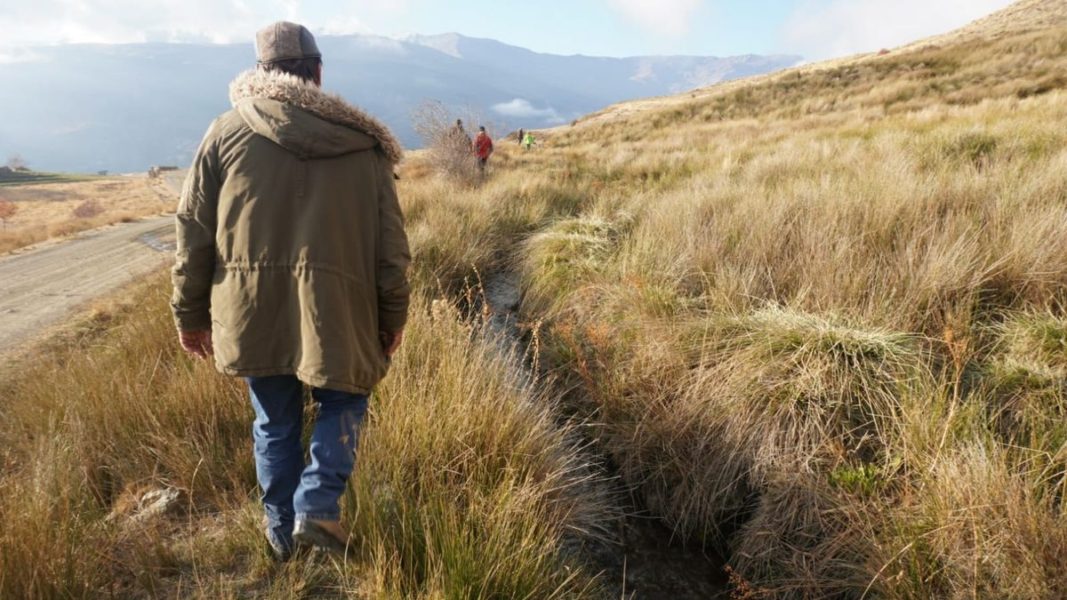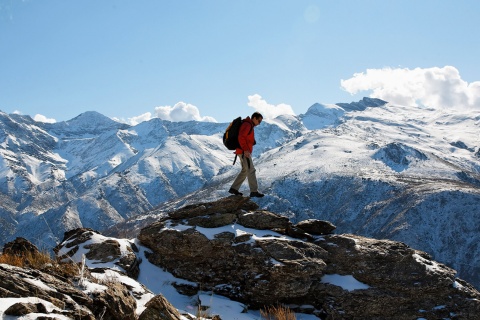Cristina Armunia Berges
On the southern face of Sierra Nevada, many of the irrigation ditches (in Spanish, acequias, from the Arabic as-saquiya, which meant “water bearer”) are once again full of water. Not all of them, but at least the most important ones for the farmers of Bérchules, a small town of 719 inhabitants. This traditional channels, of just over a meter wide in the higher areas, run along the steep slopes guarded by junipers and pine trees. At this time of the year it is already cold, which is good because, in order to grow, tender trees need their dose of shade and low temperatures.
Climate change is a constant threat. Although the mountains have already learned to defend themselves, the resulting scenarios of higher temperatures and torrential rains will change the ecosystems and the landscape as the inhabitants of the Alpujarra know it. The main goal of the Life Adaptamed project, which has been carrying out actions in the area, is to protect ecosystem services in the regions of Cabo de Gata, Doñana and Sierra Nevada against the challenges posed by climate change. Interventions are based on adapting spaces rather than directly affecting species. The recovery of this irrigation ditches, the acequias, are an example of the fight against the lack of water.

It is November and it is cold, although not as cold as it used to be. Years ago, by now, the chimneys of the Alpujarra should have been issuing smoking relentlessly. “All the studies indicate that the high mountains are especially sensitive to climate change,” explains Regino Zamora, professor at the University of Granada and scientific coordinator of the project. At an altitude of 2,000 meters, at the foot of the Mulhacén mountain, the highest mountain in the Iberian Peninsula, he recalls how people, in the 1960s, lived off subsistence livestock and agriculture and how they have been able to adapt to the new reality of conservation of natural sites and tourism. Zamora believes that the mountain will be able to assimilate the new changes.
In addition, the scientist recalls, this mountain south of Granada is heterogeneous, which means that climate impacts will not affect all its corners in the same way. To anticipate and to try to imagine the maximum number of possible scenarios, the Life Adaptamed project works in the territory recovering the medieval irrigation ditches, a colossal water network devised 800 years ago by the Arab population who lived in the Peninsula which seeks to direct the melt water, infiltrate it into the subsoil (sowing) and then recover it when there is a shortage.
The Life Adaptamed project works in the territory recovering the medieval irrigation ditches, a colossal water network devised 800 years ago by the Arab population who lived in the Peninsula.
Water plays on the surface. It could be said that it almost stops to spend as much time as possible flowing downwards. The channels through which it flows have just enough gradient to keep it flowing, but without surprises. This marvel carved in the mountain needs care, but there are fewer and fewer people with sufficient knowledge to keep the irrigation ditches clean. During the rural exodus, in addition to the departure of valuable labor, there was a great drain of knowledge that we are now trying to recover. But it is not easy.
“Maintaining the irrigation ditches is essential to maintain agriculture, the forest mass and even the water that reaches the springs in the villages,” says Javier Cano, project manager for Life Adaptamed in Spain.
The fight against climate change
The project’s researchers, together with the local population and administrations, have looked locally to find a universal solution to the problems posed by the lack of water. “Although the fight against climate change is relatively recent, we have found a solution based on cultural knowledge and nature. To retain water in the mountains is a tool for adaptation in ecosystems to house biodiversity,” says zoologist and technical coordinator of Life Adaptamed, José Miguel Barea.
They are Arab structures, from medieval times, which have probably evolved.
“They are Arab structures, from medieval times. They have probably evolved. Some may have been buried, but new ones have also been opened. Surely some of them have been preserved since the beginning,” he says.

The project “is an action of restoration of the high mountain scrub, very focused on Junipers. Junipers, in a context of climate change, have a serious regeneration problem. The main disperser of their seeds is the white-capped blackbird, which is decreasing in number. Since the seed falls and germinates, it needs climatic conditions that are beginning to fail more and more, with dry and hot years,” warns the researcher.
The traditional irrigation channel that runs through the Sierra Nevada
An acequiero to “sow water”
Antonio Ortega is a local acequiero (a professional worker in the management of ditches or acequias) and president of the Bérchules Irrigation Community. He is 58 years old and spends much of his time “sowing water”. His words show traces of the hardness of his curious profession, up and down the mountain. Rain, no matter how little, is his greatest wish because a few liters of water are capable of setting everything into motion.
When the thaw approaches, the acequieros must have everything clean and the stone gates of the irrigation ditches ready to start planting. The goal is to turn the mountain into a large sponge filled with water to be used when needed, usually in the summer months. The water is directed to a chasm or meadow on high peaks, from where it is channeled. The aim is to delay the fall of the water as much as possible, which is why the ditches have a very gentle slope resulting in crystal clear water. This is essential so that the water arms “don’t burst” because of the weeds. “The water has to go smoothly and that is a set of gates. If the water is cloudy, it clogs the pores of the soil.”
The aquifer is recharged just when it is most needed.
When the river runs dry in August, the water from the irrigation ditches is used to allow the crops to flourish. “Upstream is where the big work has to be done,” says Antonio, who for many years worked in construction, but abandoned that sector when it went into crisis. He returned to the countryside to follow in his father’s footsteps.
“When the water begins to come out of lower areas, the flow of the streams of the medium and low mountain rivers, of the springs of the villages, increases. It is an impressive work of ingenuity from the time of the Arabs,” Barea explains. “The aquifer is recharged just when it is most needed.

In Bérchules, the ditches irrigate about 80 hectares, calculates the farmer, there is a network of 40 kilometers and there could still be more, if they continue to recover them. The Adaptamed project has helped to recover eight kilometers of the 841 comprised by the entire Sierra Nevada.
What would happen if this network of irrigation ditches did not exist? “If this did not exist, water use would be much less efficient and much less optimized. Because the acequias slow down and distribute the course of the water. They are also highways of biodiversity,” says the zoologist. The Betic midwife toad, an endangered species, uses these ditches as “breeding grounds”.
An example of space management to be imitated
Life Adaptamed’s actions aim to be a demonstrative experience that can be imitated in other places that need similar solutions. “There are networks of ditches that can be managed through these systems in other places. In addition, other ditches can be built,” explains CSIC researcher Luis Santamaría. “It is a solution that can be extrapolated to any site where it is built, as it was originally done here.”
This adaptive management project proves that it is possible to help forest regeneration by working on the infiltration of slopes, “which is something that has not been usually done”, explains Santamaría. “You can make irrigation ditches or look for other techniques to favor infiltration.” “It is a very original solution that has been little explored.”
Source: Eldiario.es
This post is available in: English Español

